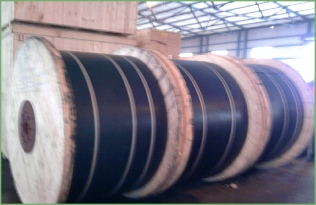








Conveyor Belting

We have an established relationship with a European conveyor belt manufacturer who manufactures canvas, steel cord and steel mesh carcass belts to DIN specifications. These belts are available with non-inflammable, hardly flammable self extinguishing and high temperature (200°C) resistant covers. They are normally operated in ambient temperatures of -25°C to 60°C. These fabric belts have a very high resistance to ply separation: min 5 N/mm between cover and carcass and min 6 N/mm between plies. Maximum elongation up to EP1250 belts is 1½% at a load equivalent to 10% of nominal strength. Each roll is supplied with a test certificate giving actual elongation and ply separation. To date no roll has tested at more than 1% elongation.
There are also special belts for use in underground fiery mines, profiled belts for carrying fine loose materials or material packed in bags up to 24° inclines. The manufacturer will entertain all enquiries with respect to special requirements such as rubber specification, belt widths up to 2600 mm, cover thickness etc.
The belts have been approved for underground coal mines in Europe and the former Soviet Union states. Category B2 belts can be used under conditions of restricted access and in the presence of potentially combustible atmosphere. The belts have flame resistance (ISO 340) with a maximum burning time of 15 seconds of a single sample. The belts are manufactured accordant to PN-EN ISO 14890 and meet the requirements of safety categories 1, 2A, 2B, 3A, 3B, 4A, 4B, 5A, 5B, and 5C accordant with PN EN ISO 12882.

Our conveyor belts are shipped on wooden reels, as depicted. This prevents any damage that may occur whilst shipping and transporting the belts to their final destination.
Furthermore, this preserves the belt during storage.